7 JAN – 10 APR 2022
Reading Room: Laiwan
-
Laiwan
LAIWAN (b. 1961) is a cultural activist, interdisciplinary artist, writer and educator with a wide-ranging practice based in poetics and philosophy. Born in Zimbabwe of Chinese parents, her family immigrated to Canada in 1977 to leave the war in Rhodesia. In 1983, she graduated from Emily Carr College of Art and Design and founded the Or Gallery. She received an MFA from Simon Fraser University School for Contemporary Arts in 1999. Recipient of numerous awards, including the VIVA Award (2023), ECU Emily Award (2021), BC Arts Council (2021), Canada Council for the Arts (2020) and the Vancouver Queer Media Artist Award (2008), Laiwan serves on national and provincial arts juries and local community committees, recent membership included the Chinatown Legacy Stewardship Group and the City of Vancouver Public Art Committee. She exhibits regularly; curates projects in Canada, the US and Zimbabwe; and publishes in anthologies and journals. Her collection of poetry TENDER: selected poems (2020) is published by Talonbooks. Leading up to her project Distance of Distinct Vision (1992) and since then, Laiwan has been investigating colonialism toward a decoloniality. From 2000, she has engaged embodiment through performativity, audio, music, improvisation, with varieties of media, along with bodily and emotional intelligence, so as to unravel and engage presence. Recent public commissions have enabled her to focus on issues of urban development, touching on poetic and philosophic themes related to current questions of environment and the built cityscape of Vancouver. Based on the unceded territories of the Musqueam, Squamish and Tsleil-Waututh First Nations, Laiwan taught from 2001-22 at the MFA in Interdisciplinary Arts Program at Goddard College (VT/WA, USA) and currently works in the Department of Arts, Reconciliation and Culture at the Vancouver Park Board. www.laiwanette.netRead More
Laiwan: Traces, Erasures, Resists highlights the artist’s attention to the material and symbolic vocabularies of print and lens-based media between 1980 and 2000, and features her early interventions into the logic of the book form and the ideology of historical and encyclopedic genres. Since the early 1980s, Laiwan has made a meaningful contribution to Vancouver’s cultural ecology through her participation with numerous queer, feminist, multicultural and visual art print publications. In addition to the audio-visual works, Traces, Erasures, Resists presents Laiwan’s archive of public writing and community interventions.
In addition to showing these writings and works in the gallery, the Belkin includes here a selection of the artist’s writings for the duration of the exhibition.
Laiwan, “Contemplating Trinh Minh-Ha.” Angles XI:1 (January 1993): 26. Collection of SFU Library Special Collections & Rare Books.
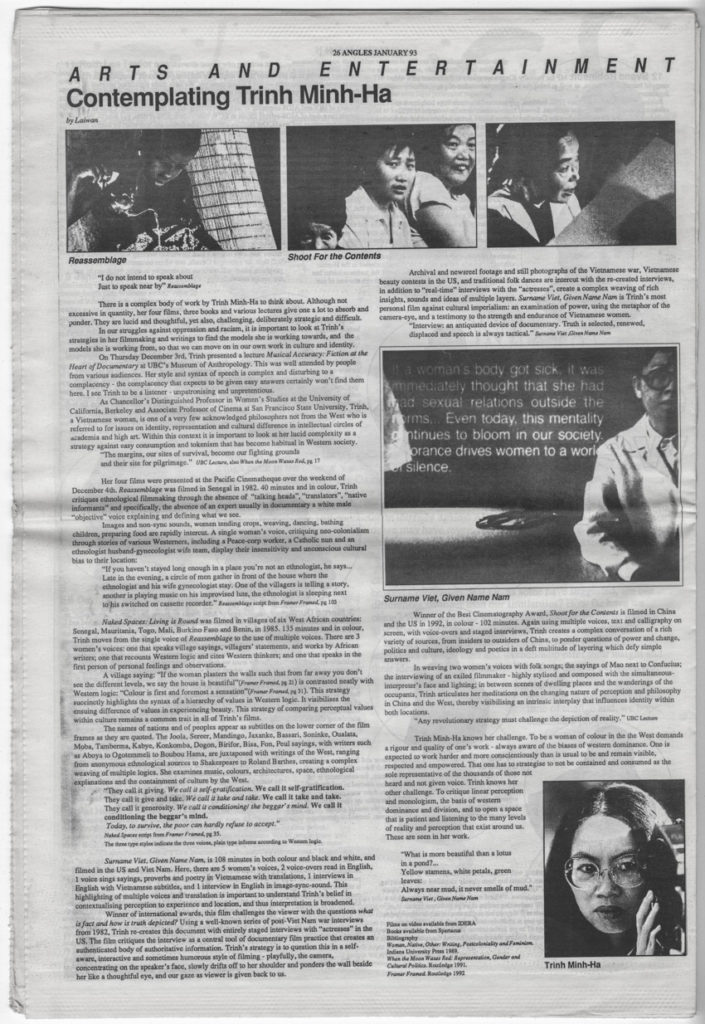 There is a complex body of work by Trinh Minh-Ha to think about. Although not excessive in quantity, her four films, three books and various lectures give one a lot to absorb and ponder. They are lucid and thoughtful, yet also, challenging, deliberately strategic and difficult. In our struggles against oppression and racism, it is important to look at Trinh’s strategies in her filmmaking and writings to find the models she is working towards, and the models she is working from, so that we can move in our own work in culture and identity. Read more…
There is a complex body of work by Trinh Minh-Ha to think about. Although not excessive in quantity, her four films, three books and various lectures give one a lot to absorb and ponder. They are lucid and thoughtful, yet also, challenging, deliberately strategic and difficult. In our struggles against oppression and racism, it is important to look at Trinh’s strategies in her filmmaking and writings to find the models she is working towards, and the models she is working from, so that we can move in our own work in culture and identity. Read more…
Laiwan, “Emotional Landscapes: Review of Lee Pui Ming’s New CD.” Kinesis. May 1994.
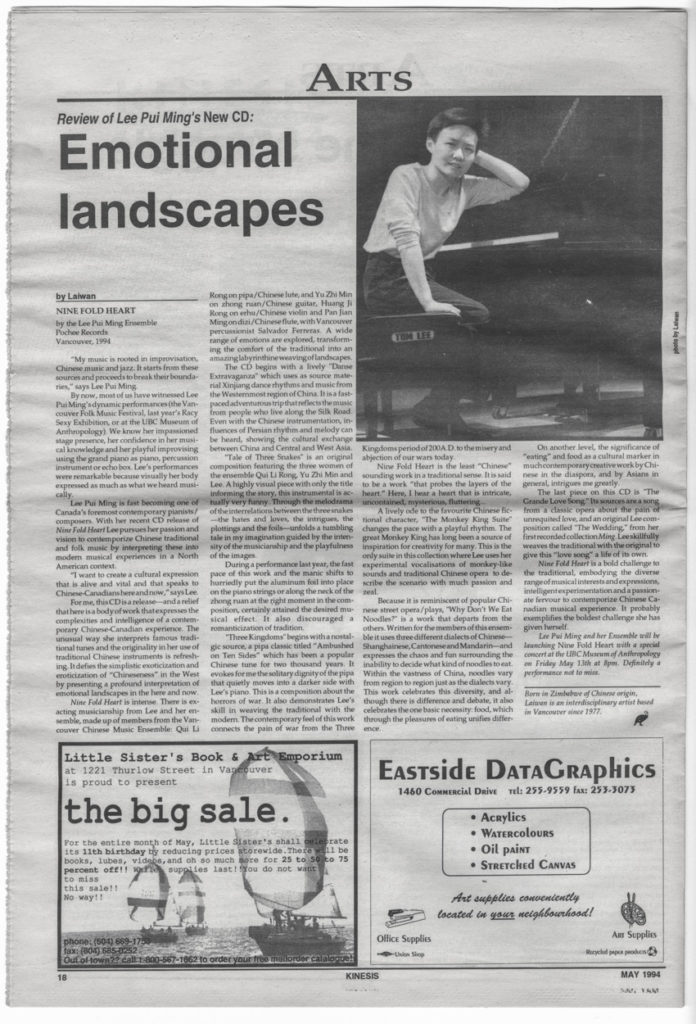 “My music is rooted in improvisation, Chinese music and jazz. It starts from these sources and proceeds to break their boundaries,” says Lee Pui Ming. By now, most of us have witnessed Lee Pui Ming’s dynamic performances (the Vancouver Folk Music Festival, last year’s Racy Sexy Exhibition, or at the UBC Museum of Anthropology). We know her impassioned stage presence, her confidence in her musical knowledge and her playful improvising using the grand piano as piano, percussion instrument, or echo box. Lee’s performances were remarkable because visually her body expressed as much as what we heard musically. Read more…
“My music is rooted in improvisation, Chinese music and jazz. It starts from these sources and proceeds to break their boundaries,” says Lee Pui Ming. By now, most of us have witnessed Lee Pui Ming’s dynamic performances (the Vancouver Folk Music Festival, last year’s Racy Sexy Exhibition, or at the UBC Museum of Anthropology). We know her impassioned stage presence, her confidence in her musical knowledge and her playful improvising using the grand piano as piano, percussion instrument, or echo box. Lee’s performances were remarkable because visually her body expressed as much as what we heard musically. Read more…
Laiwan, “From the Displaced View: Midi Onodera talks with Laiwan.” Angles V:5 (May 1988): 15. Collection of SFU Library Special Collections & Rare Books.
 Midi Onodera was born in Toronto and currently lives there. With many short experimental films behind her, she came to Vancouver in March to premiere her latest film, The Displaced View at Pacifique Cinematheque. Onodera describes The Displaced View as “a celebration of the acceptance of self, not only as a Japanese Canadian, but as a woman, person of colour, lesbian, immigrant.” The Displaced View is an accomplished film that conveys the complexities that construct personal identity and cultural definition. Read more…
Midi Onodera was born in Toronto and currently lives there. With many short experimental films behind her, she came to Vancouver in March to premiere her latest film, The Displaced View at Pacifique Cinematheque. Onodera describes The Displaced View as “a celebration of the acceptance of self, not only as a Japanese Canadian, but as a woman, person of colour, lesbian, immigrant.” The Displaced View is an accomplished film that conveys the complexities that construct personal identity and cultural definition. Read more…
Li Yuen (Laiwan), “International Lesbian Week Poster.” Angles IV:10 (September 1987): 10-11.
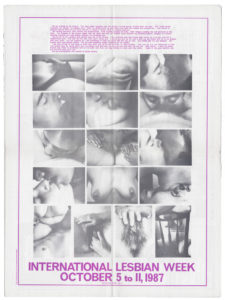 We are kissing in the shower. The warm water spraying over our bodies, running gently, tickling down our legs. Your hands slowly caressing my breasts, my nipples erect. Both my hands move up and down your back and caress your smooth ass. Your mound is pressed against mine as you move tenderly to create a friction there of ecstatic pleasure. Read more…
We are kissing in the shower. The warm water spraying over our bodies, running gently, tickling down our legs. Your hands slowly caressing my breasts, my nipples erect. Both my hands move up and down your back and caress your smooth ass. Your mound is pressed against mine as you move tenderly to create a friction there of ecstatic pleasure. Read more…
Laiwan, “Review: ZWICCT Diary: Women in Cultural Work.” Kinesis (November 1994): 16.
 1991 was the eleventh anniversary of Zimbabwe’s independence from colonial rule and Rhodesian apartheid. The nurturing of the imaginations of young women and children had become important in relation to the development of the status of women in particular and of the nation as a whole, especially in the context of the struggles of the post-colonial imperialism most countries and people in the South face. With this in mind, four women and I came together to start a task-based trust called Zimbabwean Women in Contemporary Culture Trust (ZWICCT) in Harare, Zimbabwe. Read more…
1991 was the eleventh anniversary of Zimbabwe’s independence from colonial rule and Rhodesian apartheid. The nurturing of the imaginations of young women and children had become important in relation to the development of the status of women in particular and of the nation as a whole, especially in the context of the struggles of the post-colonial imperialism most countries and people in the South face. With this in mind, four women and I came together to start a task-based trust called Zimbabwean Women in Contemporary Culture Trust (ZWICCT) in Harare, Zimbabwe. Read more…
-
Laiwan
LAIWAN (b. 1961) is a cultural activist, interdisciplinary artist, writer and educator with a wide-ranging practice based in poetics and philosophy. Born in Zimbabwe of Chinese parents, her family immigrated to Canada in 1977 to leave the war in Rhodesia. In 1983, she graduated from Emily Carr College of Art and Design and founded the Or Gallery. She received an MFA from Simon Fraser University School for Contemporary Arts in 1999. Recipient of numerous awards, including the VIVA Award (2023), ECU Emily Award (2021), BC Arts Council (2021), Canada Council for the Arts (2020) and the Vancouver Queer Media Artist Award (2008), Laiwan serves on national and provincial arts juries and local community committees, recent membership included the Chinatown Legacy Stewardship Group and the City of Vancouver Public Art Committee. She exhibits regularly; curates projects in Canada, the US and Zimbabwe; and publishes in anthologies and journals. Her collection of poetry TENDER: selected poems (2020) is published by Talonbooks. Leading up to her project Distance of Distinct Vision (1992) and since then, Laiwan has been investigating colonialism toward a decoloniality. From 2000, she has engaged embodiment through performativity, audio, music, improvisation, with varieties of media, along with bodily and emotional intelligence, so as to unravel and engage presence. Recent public commissions have enabled her to focus on issues of urban development, touching on poetic and philosophic themes related to current questions of environment and the built cityscape of Vancouver. Based on the unceded territories of the Musqueam, Squamish and Tsleil-Waututh First Nations, Laiwan taught from 2001-22 at the MFA in Interdisciplinary Arts Program at Goddard College (VT/WA, USA) and currently works in the Department of Arts, Reconciliation and Culture at the Vancouver Park Board. www.laiwanette.netRead More
Related
-
Exhibition
7 Jan – 10 Apr 2022
Laiwan: Traces, Erasures, Resists

Laiwan: Traces, Erasures, Resists highlights the artist's attention to the material and symbolic vocabularies of print and lens-based media between 1980 and 2000 and features her early interventions into the logic of the book form and the ideology of historical and encyclopedic genres. Guest curated by Amy Kazymerchyk, the exhibition title references processes related to printmaking, while also speaking to the absent narratives, redacted perspectives and critical refusals that are latent in official publications.
[more] -
Exhibition
7 JAN – 10 APR 2022
Outdoor Screen: Laiwan
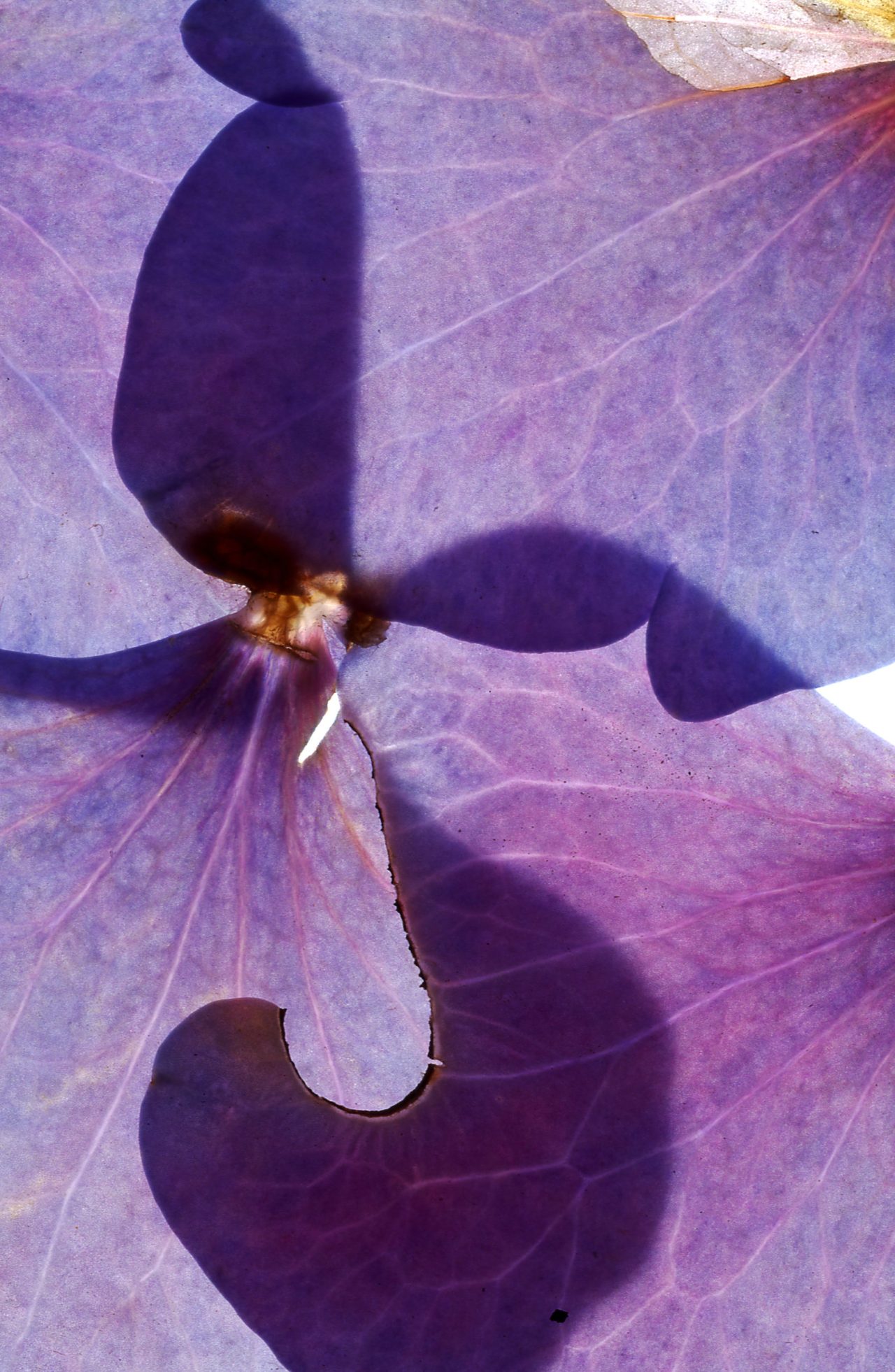
From January to April, the Belkin's Outdoor Screen sets a number of works in relation to one another, drawing associations between the exhibition Laiwan: Traces, Erasures, Resists in the gallery, the longterm artist's residency in the Outdoor Art program and the affinities to be found with research partners on campus.
[more] -
Tour
Tours: Laiwan: Traces, Erasures, Resists

Tours and discussions of Laiwan: Traces, Erasures, Resists can be arranged according to current COVID-19 safety protocols from Tuesday to Friday for groups and classes, lasting 50 minutes and longer. For more information, please contact Belkin Public Programs by email at belkin.tours@ubc.ca or by phone at (604) 822-5600.
[more] -
Event
Outside the Belkin: Laiwan
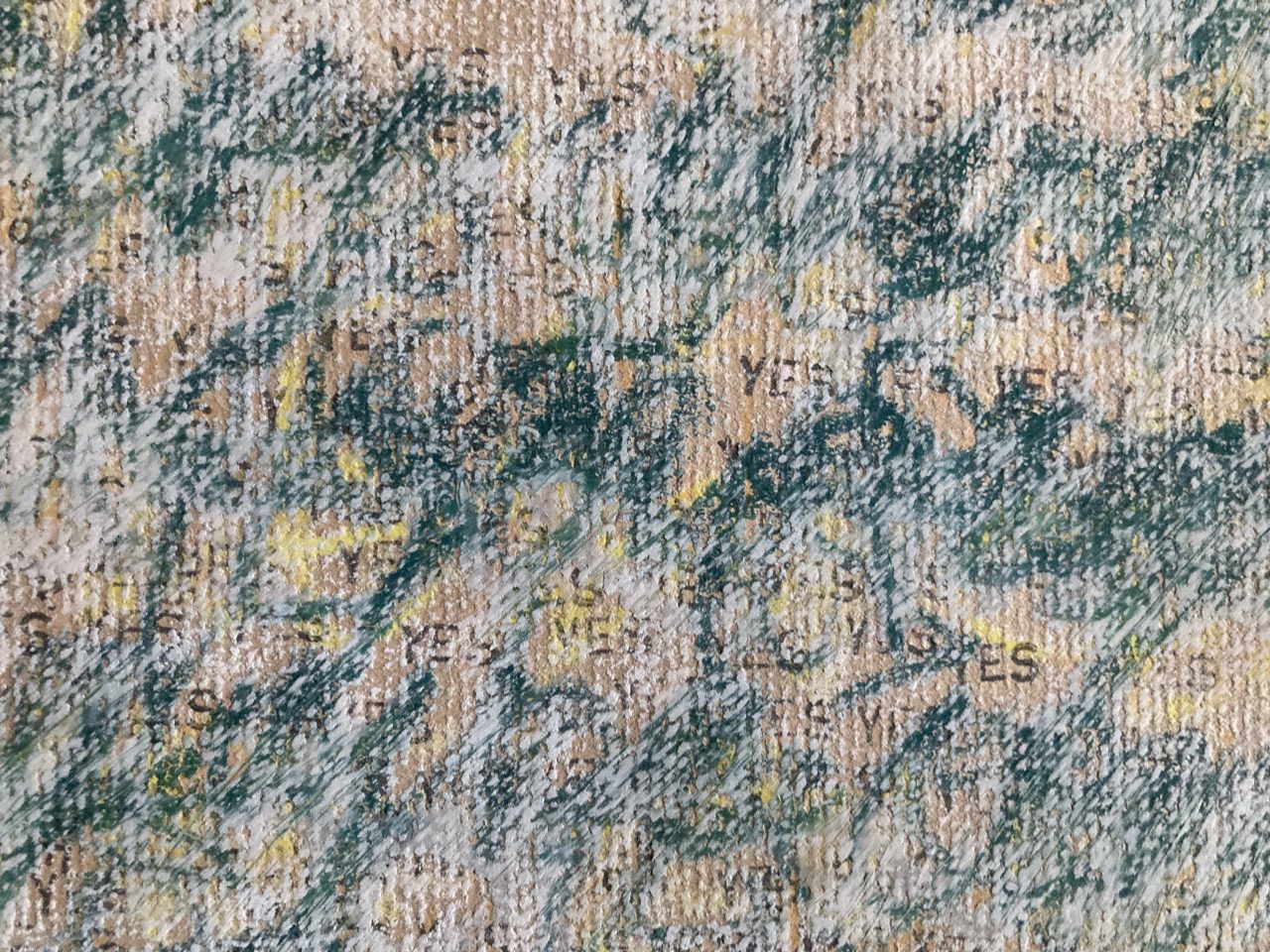
Over the course of her career, Laiwan has nurtured extended connections to many arts and community organizations across the city through her engagement with artist-run centres and her participation with queer, feminist, multicultural and visual art print publications. As a way of honouring and highlighting these relationships, the Belkin is cross-promoting events that Laiwan is engaged in across the city and more widely. This list is growing and changing; check often for updates.
[more] -
Tour
SATURDAY 15 JAN 2022, 2-3:30 PM
Artist and Curator Tour: Laiwan and Amy Kazymerchyk

On January 17, Laiwan and curator Amy Kazymerchyk walked through the Belkin discussing their exhibition Laiwan: Traces, Erasures, Resists. The two touched on the latent traces, erasures and resists in the artistic and curatorial processes behind the exhibition. While the tour was to take place in front of a live audience, COVID-19 restrictions required that the conversation take place behind closed doors.
[more] -
News
18 Jan 2022
Laiwan: Resources for Research

The following are resources related to the artists in Laiwan: Traces, Erasures, Resists. This list is not exhaustive, but rather comprised of suggested readings compiled by researchers at the Belkin. These readings are intended to provide additional context for the exhibition and act as springboards for further research or questions stemming from the exhibition, artist and works involved. Following the introduction, resources are arranged along the themes of traces, erases and resists as explored through and adjacently to Laiwan’s work. This compilation is an evolving and growing list, so check back in the future for more additions.
[more] -
News
03 Mar 2021
Works from the Collection: Laiwan
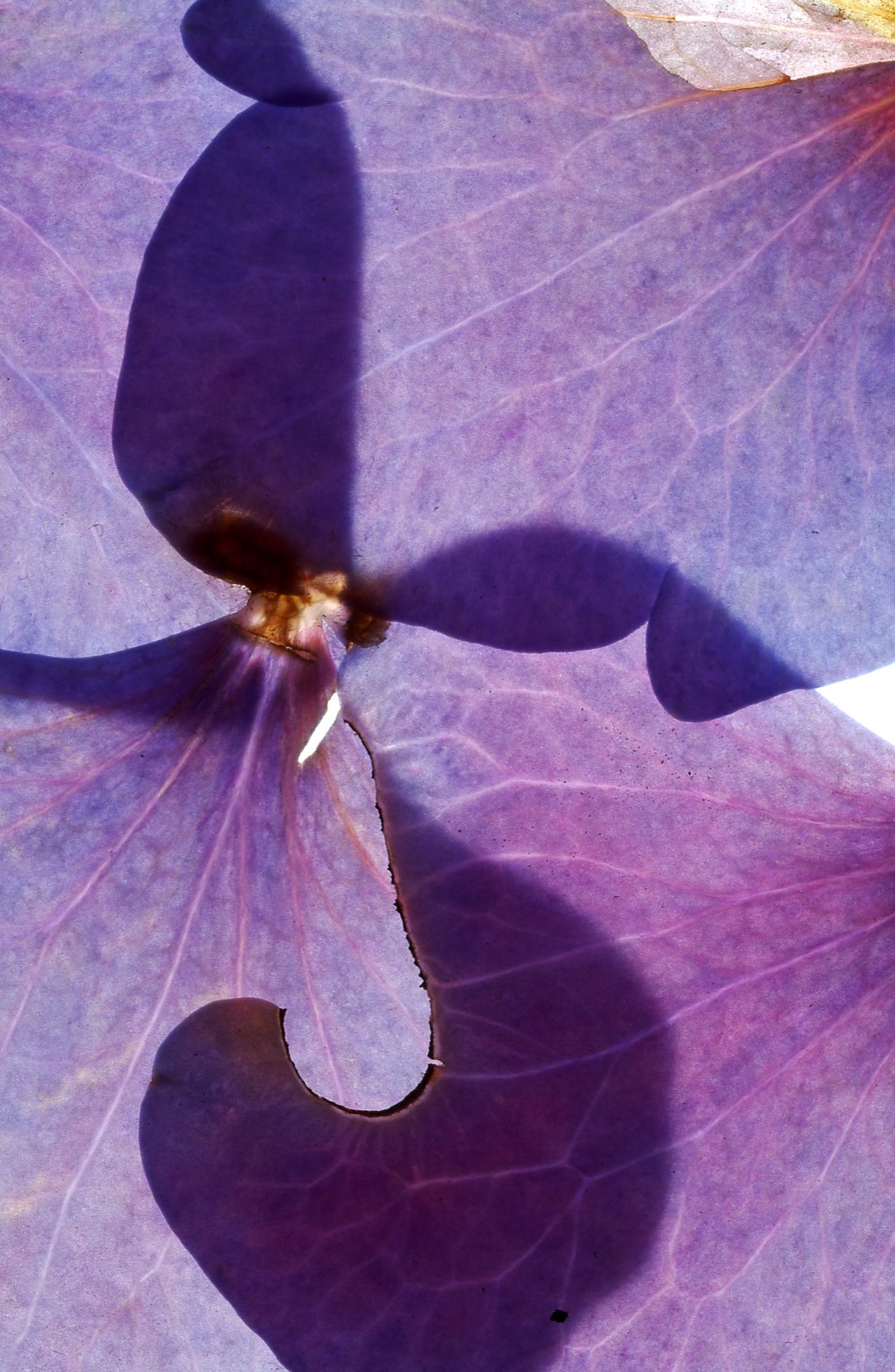
Laiwan writes, "Begun in 1987 investigating the questions, What is an image? What is a photograph?, she who had scanned the flower of the world... is an ongoing project where I collect flowers from the city I am showing in, placing the petals into slide mounts."
[more]